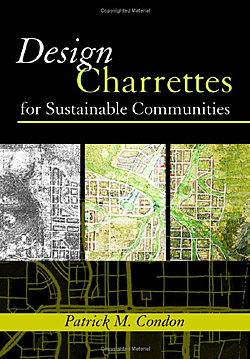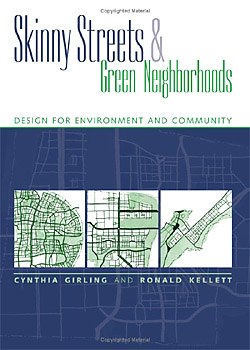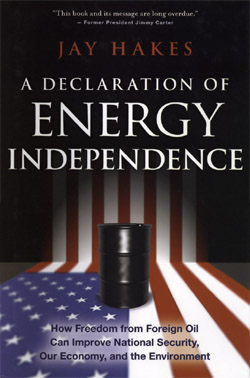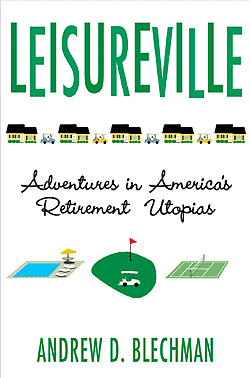
|
||
|
Issue 51 |
|
15 September 2008 |
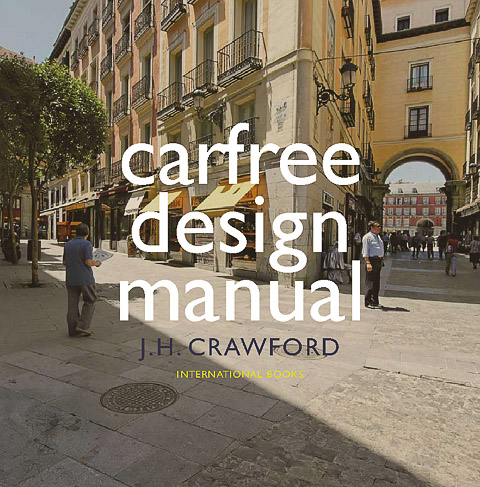 Carfree Design Manual cover Announcements
Carfree Design ManualThe book is in final production and should go to the printer this month. It will be printed in full color throughout. I had not been particularly enthusiastic about the change to color but have now realized that it will significantly improve the book. We expect books to be available in the Netherlands in December and in the USA in April 2009. Other English-speaking nations should be able to get the book in the first half of next year. The final tally is 600 pages, 81 drawings, and 888 photographs. I'm exhausted, but it was worth it.Carfree Cities AvailabilityThe paperback edition of Carfree Cities is still widely available. The hardcover version is now scarce.World Carfree DayA Wiki sponsored by World Carfree Network lists all of the known World Carfree Day events. If yours is missing, please add it!German ConferenceThe 4th Autofrei Leben! conference, "Carfree Housing: The Lessons from Completed Projects" will be held 26-28 September 2008 in Cologne. The host is autofrei leben! e.V. [carfree life] of Berlin. This is a German-language conference. Information is available at www.autofrei.de.ThanksThanks to the many stringers who have forwarded stories to Carfree Times. I no longer name people for fear of slighting someone by overlooking a name. |
|
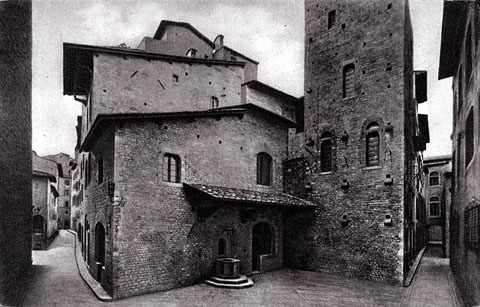 Florence A Century AgoSome of the best postcards I have accumulated are scattered throughout this issue. These scenes give us something to strive for.
News Bits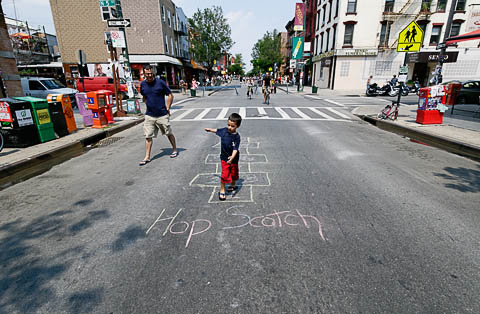 Brooklyn Summer Streets, 26 July 2008 ©2008 J.Crawford Summer in New YorkIt was a busy summer in New York City, which is the only US city where cars make up a comparatively small percentage of the modal split. Notwithstanding their relative unimportance to mobility in New York, cars have dominated the streets of the city for a century. They lost some ground this summer, literally and figuratively. It was long overdue.I was only able to attend one of the events, the closure of about six blocks of Bedford Street in the Williamsburg section of Brooklyn. According to folks from Transportation Alternatives, this simple-seeming closure took a lot of time and energy to organize, but they seemed to think it had been time well spent. 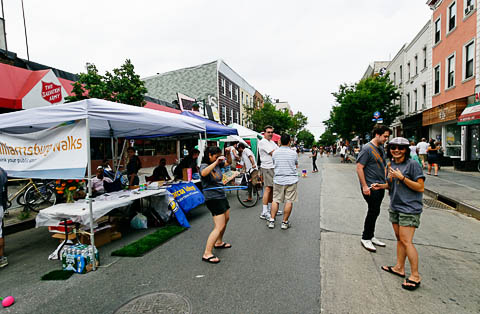 Brooklyn Summer Streets, 26 July 2008 ©2008 J.Crawford The Brooklyn event closed the street to cars for four mid-summer Saturdays from noon to 7 PM. I attended the July 26th event, which took place on a nice if rather warm day. The crowds built during the afternoon, and when I left around 4 PM the streets were fairly full. The organizers had not sought to host a street fair, merely to return the streets to their rightful users: people. In this they most certainly succeeded. The better-known event was also of much larger scope. A major north-south route was opened for pedestrians and cyclists from the Brooklyn Bridge to East 72nd Street. Park Avenue, Fourth Avenue, and Lafayette Street were closed to cars between 7 AM and 1 PM on three Saturdays, August 9, 16, and 23.
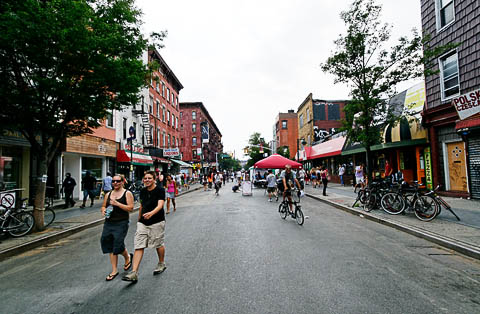 Brooklyn Summer Streets, 26 July 2008 ©2008 J.Crawford The mayor said the plan was "designed to get New Yorkers and visitors alike to come out and enjoy the streets and the city in a new way." He expected that it would draw several hundred thousand participants. He anticipated some disruption but thought that the benefit would far outweigh the minor nuisances. He plans to repeat the event if popular opinion supports it. "Itís going to be a pretty great day," said Charlie McCorkell of a Soho bike shop. "I hope itís a preliminary thing, though, for taking the main streets away from cars. It will probably be 10 years before they do it during a weekday, but Iím hoping it becomes a regular program." The route passed Grand Central Terminal, where the street was filled with pedestrians and bicycles. Bike bells and human voices replaced the normal roar of traffic along miles of Park Avenue and other major avenues to its south. Thousands of people attended the Manhattan event, which featured a large range of activities. Many simply took the opportunity to stroll down streets normally filled by speeding cars. Suddenly, there was room enough for pedestrians and cyclists alike. The events apparently had a festive, even jubilant, atmosphere. Many appreciated the respite from the unrelenting noise. People enjoyed biking without fear of getting run down by a taxi. The route was crossed by vehicular traffic at 24 streets, where police directed traffic. 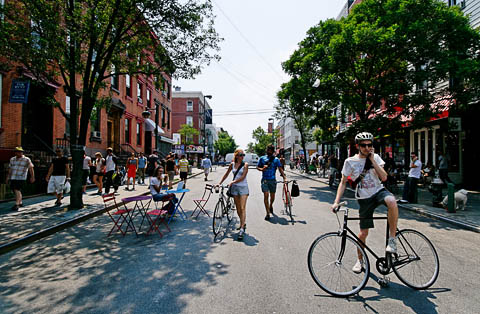 Brooklyn Summer Streets, 26 July 2008 ©2008 J.Crawford A Streetfilms reporter said: We'll spare you the 200 adjectives we could list about how transformational it was, for it was beyond anything on the printed page. The general consensus was that the event succeeded beyond even the most hoped for expectations and would pass even the most pessimistic of measuring sticks. A page has been turned, clearly there is no doubt: the future will hold many more large scale street openings for pedestrians, cyclists, runners, children, dog walkers, dancers, and any other reasonable livable space use.As usual, some merchants feared for their trade. Although there have been no reports that I have seen, I would suspect that the calm following the events means that, as usual, the merchants were too busy counting their cash to complain. Taxi drivers had worried that they would lose fares, but one cabby praised the event. "All these people are going to be tired when they put their bikes away. Weíre going to make a lot more money." Also this summer, city officials announced the permanent closure of two lanes of Manhattan's Broadway between 34th Street and Times Square. The change is to make room for pedestrians and sidewalk cafes. The streets will be rearranged to make better use of the space. This is actually a bit of a sleeper event, as it was done without a lot of fanfare, but the results should be large, and it represents the first step in permanently reducing the amount of street space devoted to cars in New York. I also discovered a long-standing street closure that no long draws any notice. Jefferson Market regularly closes several streets in Greenwich Village for a weekend market that is heavily patronized. There were some very small events as well. One street next to Travers Park in the Jackson Heights neighborhood of Queens was closed on Sundays. One resident reported teaching his young daughter to ride a bike and noted that it would not have been possible if there were cars on the street. The street served as a temporary extension of the neighborhood's only park, a small one at that. The permit was actually granted under the century-old Play Streets program, established at the behest of the Police Athletic League during a kinder, gentler epoch in American history.
"No Traffic on a Saturday? Well, No Cars, Anyway"
For detailed information about the evolution of these events, see: |
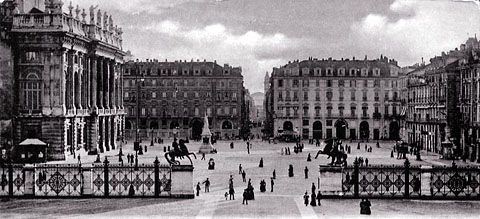 Turin First New Carfree City To Be Built in Jordan?It may seem an unlikely spot, but Amman, Jordan, will build a new, highly-sustainable community on the outskirts of that city. To my knowledge, this is only the second truly urban-scale sustainable project that has been proposed; the initial population would be 700,000, expected to grow to a million in just five years. (The Dongtan project near Shanghai was the first.)It is by the same team of planners who designed Abu Dhabi's much smaller carbon-neutral community, Masdar. The new city is not expected to be entirely zero-carbon, but the same technologies will be employed as at Masdar. This implies that Amman's new city will also be carfree. One advantage of the Amman site is that the weather is temperate, with warm summers and cool winters. Abu Dhabi is hot all year round and reaches extreme temperatures in the summer. Jordanians are already very frugal in their use of water, which will also help sustainability. King Abdullah decided to invest US$7 billion to build 120,000 units of low- and middle-income housing in a city with a chronic housing shortage. Construction will start at the turn of the year, with 100,000 houses completed within five years. This project will not enjoy the lavish funding seen at Masdar, which in many respects makes it a more interesting project, especially given its large size.
"Carbon-neutral city planned for Jordan" 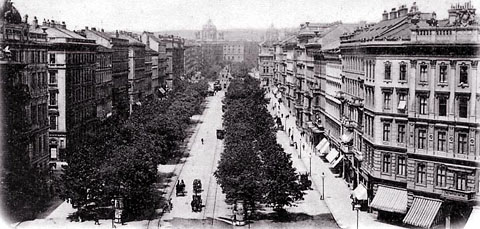 Vienna China to Take the High Road?The assumption that China is merely following the blueprint of Western industrial capitalism may not hold true for much longer. China is realizing that it cannot pursue the Western model as it prepares to urbanize hundreds of millions of people during the next few decades.China is planning to build at least 10 eco-cities. The plans are apparently ambitious and may not be fully realized, but it clearly marks a major course change for the world's largest nation. With these plans, China will probably forge far ahead of the West in developing best practices for sustainability. Peter Head recently suggested to an audience at New York University that American planners may one day be studying at places like Shanghai's new Dongtan. (See Carfree Times #41 and Carfree Times #47). Dongtan is not entirely carfree but will clearly be very car-lite. New freight systems are also being studied. Dongtan will feature when China hosts a World's Fair in 2010.
"Green Living, Chinese-Style" 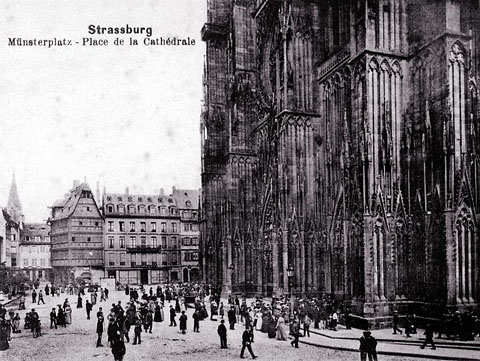 Strasbourg Carfree StockholmAfter the first year of Stockholm's congestion charge, the local Left party has suggested putting carfree zones in central Stockholm. They want to start with "the older parts of the City area" and exempt taxis, the disabled, ambulances, fire trucks, and certain deliveries. ["The older parts of the City area" probably means the central station and a few blocks north and east, as well as Gamla Stan, the medieval town.]In Sweden, 500 people die each year from the unhealthy outdoor air. A carfree inner city would make the city prettier, with a rich street life where children can play on the streets without traffic noise ringing in their ears. As models, they mention Freiburg, Ghent, Zermatt, Copenhagen, Groningen, Strasbourg, Curitiba, and Venice. Carfree areas have resulted in higher sales from merchants, not lower. They point out that so-called green cars do not solve the issues of pollution, congestion, noise, and accidents. Nor do they solve problems with manufacturing alternative fuels. The boom of green cars has reduced average car emissions per kilometre, but total emissions are rising since we continue to drive more and more. They conclude by noting that the rule of cars is not God-given and it's time to reclaim the streets, for the sake of a pleasant life and acting responsibly in the face of climate change. The article, Dags för bilfri innerstad, is signed Ann-Margarethe Livh, Left Party, in opposition at city council, and Jens Holm, Left Party, European Parliament. Translated for Carfree Times by Erik Sandblom Translator's note: The conservative-liberal majority coalition is not unambiguously pro-car as the Swedish text states. The new conservative council member for the environment, Ulla Hamilton, said 12 June 2008 that she wants to reduce emissions by, among other things, reducing car traffic and transitioning to so-called green cars. The congestion charge has become a non-issue following its approval by a local referendum in 2006.
"60 procent fler cyklister i Stockholm" 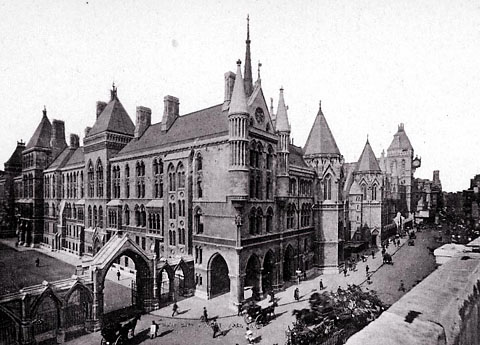 London UK Eco-Town Plans: A Little Bit CarfreeEngland is planning a series of up to ten eco-towns, and the plan requires:
As is to be expected, a tussle between the national authorities and local authorities is developing. The central government maintains, however, that the towns would be required to conform to existing local planning procedures. Of the thirteen sites now in contention, up to ten will be accepted early next year, and planning would commence.
"'Car free commute' eco-town plan" 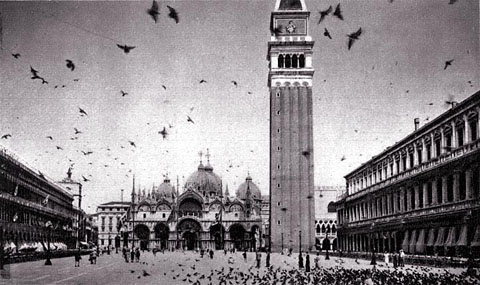 Venice California Draws a Bead on SprawlCalifornia, where it all started, looks like it will also be the place where it all ends. The state has declared open season on sprawl. This comes in the face of an increase in vehicle miles that is outpacing population growth by 50%.So far, the measures are fairly modest, but this is a sea change. The state is trying to get people to drive less in order to reduce climate change. The state legislature will probably adopt a law that aims to reduce climate change by limiting sprawl. The principal approach is to target state funding for infrastructure at projects that do not encourage sprawl. California is already committed to reducing its greenhouse gas emissions to 1990 levels by 2020 (a modest-enough goal). The state recognizes that more efficient cars and factories will not achieve the target. Sprawl had to go. Regional planning groups will submit land-use plans to the state. If the state finds that the plans will contribute to climate change, then the plans will be rejected. Only after a plan is approved will the state subsidize transport infrastructure. Even the development industry has seen the writing on the wall and is supporting the current bill as being the best compromise they are likely to get. In many ways, this thinking is an outgrowth of the urban growth boundary that was adopted years ago by Portland, Oregon.
"Legislature takes aim at urban sprawl and global warming" 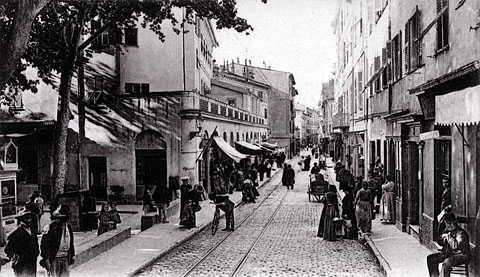 Menton Rich Drivers Starving Poor FamiliesOne more attempt to save the car and make it sustainable has failed. It has been known for years that the conversion of corn into ethanol produced little, if any, net energy gain. So why did the USA embark on a program to farm corn and turn it into ethanol for blending with gasoline?ADM and Cargill made large political contributions to the Bushistas. In return they got legislation that gives huge tax incentives for ethanol production and mandates a 10% ethanol content for gasoline. Now the crows have come home to roost in the form of sharply higher food prices that are starving poor families around the world. Food prices are up a shocking 75%, according to a World Bank report that was obtained by the ever-useful Manchester Guardian. Rising food prices have sparked riots around the world. In Egypt, the 40% of the population that is poor now spends 60% of its income on food. Wheat (much of it bought from the USA) doubled in price, and bread riots became a regular occurrence. The report is a detailed analysis of the food crisis and was conducted by a widely respected economist at the bank. The figures refute the claims of the Bush government that food-to-fuels production caused a mere 3% rise in food prices. Apparently, the report was withheld from publication in order to avoid embarrassing Bush. The price rises were not, as Bush claimed, due to rapidly-rising demand from India and China. Other claimed causes of price increases were also largely discredited by the report. The increases stem from three principal causes. First, grains were diverted from the food chain into fuel production. (More than a third of US corn is now used for ethanol production; half of EU vegetable oils go into biodiesel.) Then farmers devoted land to fuel-stock production rather than food. These two in turn caused massive speculation on the commodities markets, driving prices up. David King, former UK chief scientist, said, "It is clear that some biofuels have huge impacts on food prices. All we are doing by supporting these is subsidising higher food prices, while doing nothing to tackle climate change." And that about sums it up.
"Secret report: biofuel caused food crisis 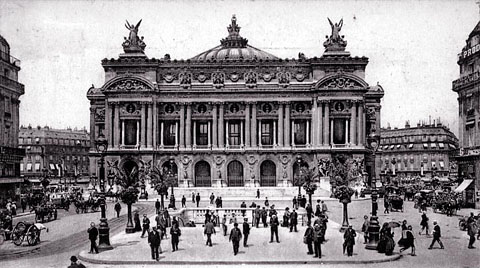 Paris Fuel Costs Affect GlobalizationLevels of global transport reached absurd proportions in ways that I had never suspected. Naomi Klein, the author of The Shock Doctrine: The Rise of Disaster Capitalism, said, "If we think about the Wal-Mart model, it is incredibly fuel-intensive at every stage, and at every one of those stages we are now seeing an inflation of the costs for boats, trucks, cars."The cost of shipping a 40-foot container from Shanghai to the USA rose from $3000 at the turn of the century to $8,000 today. This has occurred despite a fuel-saving 20% reduction in the operating speed of container ships. The extreme level of freight tonnage was only revealed when a sharp increase in the price of bunker oil, used to power ships, raised the price of sea freight. Let's consider two examples:
"Shipping Costs Start to Crimp Globalization" 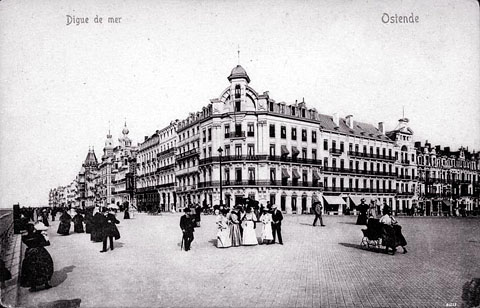 Ostende The Successes of Fare-free Public TransportPublic transport as if it mattered: no fares to hassle with, bike racks on every vehicle, wheelchair lifts, comfy shelters, coordinated schedules, friendly operators . . . and no ads. Hasselt is widely believed to have led the way ten years ago, but in fact Whidbey Island in the state of Washington adopted the strategy twenty years ago.Here are some numbers to compare what Island Transit did last year to what BC Transit accomplished in the Regional District of Nanaimo on Vancouver Island. The results are impressive. The author of the original story reports for a small-town paper in British Columbia and gave the following statistics comparing Whidbey Island with his own Nanaimo.
Island Transit is financed entirely from a 0.6% local sales tax. The nearly 50% fare-recovery rate in Nanaimo is actually comparatively high for North American operations and is probably a result of relatively high fares. Buses in Nanaimo often run with light loads, whereas Island Transit carries plenty of passengers. Island Transit also operates an extensive para-transit service (not reflected in the numbers above). Widespread fears that fare-free transit will attract deadbeats and lead to vandalism are not borne out by the Island Transit experience. This is one of the most common reasons given for requiring a fare. The driver can simply eject an unruly rider, which seems to prevent problems from arising. Even the kids are polite and well behaved. One operator noted that teenagers "more often than not say 'thank you' when they get off." But what of the much better known experiment in Hasselt? Transit there has been fare-free for ten years now. The city has 70,000 residents and a large number of commuters from the hinterlands. Downtown service runs on a five-minute headway, which is short enough to encourage people to actually use the service. Other service runs on headways up to 30 minutes. The system was considerably improved before fares were dropped. There had been only three routes; today there are eleven. Annual service hours are up five-fold, with annual ridership around four million. The system is entirely financed from taxes, with an annual operating budget of €5,119,968. Jean Vandeputte of the Hasselt government said, regarding the conversion of other systems to the fare-free model: To be successful, I think that the public transport system must not be crowded at the start. Our project was originally organized to attract more passengers and to have less cars in the city centre. The buses also need separate lanes, because travelling by bus has to be faster than by car, so the infrastructure of intersections and streets has to be adapted. The buses have to be modern, clean . . . you need to have more bus stops. And the shelters must be attractive.When Hasselt went fare-free, ridership increased 783% on the first day. By the end of the first year it had increased to 900% over the previous year. Ridership continues to climb to this day. One of the important arguments made in Hasselt was that public transport systems simply make better use of public space, thereby improving the quality of life. This has been coupled with bike-sharing schemes, as the city recognizes that cycling is the most sustainable mode of all. Wheelchairs and baby strollers are also on loan. A significant part of downtown has been made carfree. Businesses in Hasselt now understand that limiting car access dramatically increases the number of customers. The once-clogged innermost ring road has been turned into a pedestrian, cycle, and transit street. Other streets provide relatively little capacity for cars but are rarely congested. Over all, the city has saved millions on transport infrastructure and avoided the construction of another, more distant ring road. Taxes are actually down as a result. Hasselt Mayor Steve Stevaert said, "We don't need any more new roads, but new thought highways!"
"Fare-free transit on Whidbey Island is a 20-year success story." 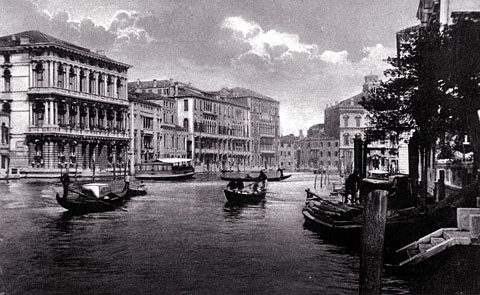 Venice Rail Capacity Shortages Loom in the USABy 2035 rail traffic in the USA may far outstrip capacity. Some in the rail industry foresee chaos. The concerns relate, so far, only to freight service. Fewer than half of Amtrak's trains are on time, partially as a result of system delays, but their trains account for a very small percentage of total traffic. The problem likely has as much to do with Amtrak as with any actual capacity limitations, as Amtrak is also unable to operate on-time service even on the one line (Boston-to-Washington) that it actually owns and controls.The USA, despite its backwardness in passenger rail service, actually compares favorably to Europe in terms of freight traffic. Whereas in Europe the modal share for rails is in the single digits, US railroads shipped 37% of total domestic ton-miles the last time I checked. The problem is probably overstated. A century ago, before advanced signalling systems had come into use, most US railroads of any importance were double-tracked (and some had four tracks). During the past 50 years, many lines have seen track torn up, leaving just a single track. At the same time, the total tonnage being moved through the system actually increased. However, in most cases, the right of way (and even bridging) is still in place, and all that is required is to re-lay track. This is fairly expensive, but cheap in comparison to the original costs of building these lines. Track is now laid by highly automated machinery, and the resultant continuous welded rail wears well and gives a smooth ride. Many of the rights-of-way that no longer have track are still intact, and these lines could also be quickly relaid in the event of need. One analyst said that the crisis was being talked up as a way to increase Federal subsidies. If traffic is increasing so rapidly, the capital markets should have no reluctance to make the necessary investments. No need for corporate socialism. Of course, the Interstate Rail plan could provide a rapid and massive increase in US rail capacity. But it seems likely that US freight tonnage will decrease in the years ahead as the nation is forced to move away from a consumption-based economy. This is even true despite the near certainty that much of what now moves by truck will be shifted to rail as fuel costs continue to rise.
"Freight system near a train wreck 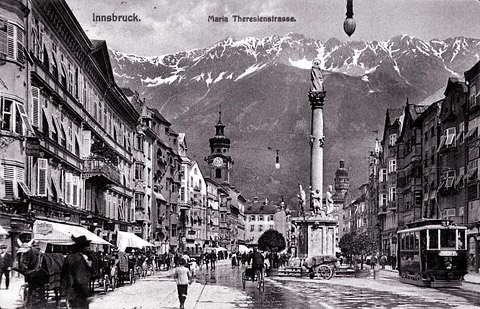 Innsbruck Renaissance on RailsStreetcars are making a comeback on the streets of France. Cities like Nantes and Marseilles are pinning their hopes on new, high tech streetcars.The "tram," as it is known in France, gives Mulhouse, a French city once struggling with structural change, new pride and confidence. "Citizens could participate in all stages of planning," said vice mayor Samuel-Weis. "They could express their preferences about the shape of the train or its colors. The project was popular even before the first train began operation." In neighboring Strasbourg, where the last streetcar was scrapped in 1960, the car was once king. In 1971, French president Georges Pompidou announced the "necessity to adapt the city to the car." It looked like the car would prevail forever. But today, trams are back, and riding the tram is cool - and convenient. "Always on schedule, practical, safe," says a young mother. At the stops, the ground is elevated to the level of the train doors. "Buggies? No problem. Nothing like that nightmare at bus stops or getting to the platforms in metro stations." What happened? Up to 70,000 cars a day once jammed the medieval streets of Strasbourg. What to do next? A metro was planned, but this approach was abandoned because of groundwater problems. In 1989, Catherine Trautmann ran for mayor on the slogan "I will make the tram come true!" She was elected. It was the beginning of a remarkable success story for the city. When introduced, the new Eurotrams slipped so quietly through the streets that many pedestrians vacated the tracks only when the alarm bell was rung. A return to light rail systems marks a major turning point in France's urban traffic planning. The goal is to "reopen the enclaves." Light rail reconnects secluded, run-down neighbourhoods with the city centre, thus providing a social service. In Bordeaux the tram provided a new connection to the other bank of the river and the neglected suburb of La Bastide. "Finally, people aren't isolated any more," cheered Michèle Delaunay, socialist deputy of the district in the National Assembly. "The tram has given Bordeaux an enormous boost in prestige." Businesses benefit from the new transit connections that have revived Strasbourg's downtown. All five tram lines operate at full capacity, thanks to a sensible fare policy. Parking a car on a park-and-ride site costs €2.70, including a tram ticket. Excerpted for Carfree Times by Ulrich Nehls. Ed. note: For existing cities, especially those with a population between 300,000 and one million, the tram is a nearly ideal means to reduce car dependence and prepare for the eventual change to carfree neighborhoods. Just as was the case a century ago, when the first electric trams were becoming a common sight on city streets, trams are comparatively inexpensive to implement, are pleasant to use, and provide quite good service at comparatively low operating costs. The principal limitation on tram service is passenger capacity, and this problem is now apparently starting to crop up in Strasbourg. Trams are less suitable as the principal mode of transport in larger cities, where metros usually serve better, but even there the tram is a very useful adjunct. One thing is necessary to ensure their success: cars must be kept out of their way.
"Renaissance auf Schienen" 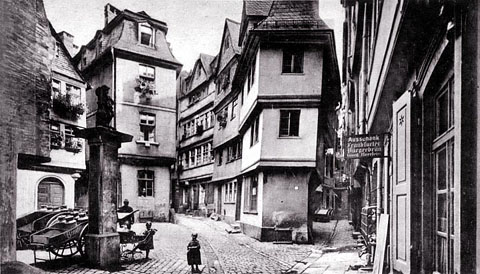 Frankfurt CO2 Sequestration Plans FailEven as the coal industry talks up the sequestration of CO2 emissions in deep ground formations, the technology is failing. Bush has supported the plans and spent years praising the prospects of "clean coal," as it is known. It is reported that both McCain and Obama also support the approach, along with many in Congress. Even some environmentalists support it.In January, the US government canceled funding for a demonstration project in Illinois that has everything: coal, power grid interconnection, and ground formations supposedly able to store CO2 for aeons. Other projects in five US states are also on hold. Rising costs are held at least in part to blame. The technique still has never been demonstrated to be safe, effective, and economical. It has not been shown that the CO2 will stay in the ground. Cost-effective design of the power plants has not been achieved. Groundwater contamination and legal responsibility for damages remain a concern. Only a few, small projects continue, and it is doubtful if the technology can be deployed in time to meet the need, which is really less than 20 years if global warming is to be tackled, and much sooner would be much better. Instead, it is likely that another generation of conventional coal-fired plants will be built, with devastating consequences for the environment and the climate. The most significant failure involved FutureGen, a project Bush announced in 2003. A subsidized utility consortium was to build a plant in Mattoon, Illinois, that would test the proposed technologies. The method involved coal gasification, pollution capture, and power generation using the resultant gas. The CO2 would have been compressed (at a large cost in energy) and pumped into deep soil layers. The site was then to have been monitored for escaping CO2. When cost nearly doubled, the government pulled out, fearing even further escalations. Congress might yet save the project. The Department of Energy has offered to build the CO2 sequestration portion of a new coal plant. The utility would have to bear the risk of cost overruns, which may dampen enthusiasm. These difficulties also threaten the next-generation coal plants, which would also have depended on coal gasification to reduce emissions and increase efficiency. Two such plants are already operating in the USA but have been plagued by technical problems and high costs. Utilities have canceled most of their gasification projects under pressure from utility regulators fearing high costs. A sole survivor in Edwardsport, Indiana, may eventually include equipment to capture 20-50% of its CO2 emissions and inject them into the ground. Other approaches are being tested in various places, including retrofits for conventional coal plants and schemes to burn coal in pure oxygen. None of these projects is very far advanced. The feasibility of the approach has never really been demonstrated. EPRI, an industry group, estimated that it would take up to 15 years to demonstrate the feasibility of the technology in a pilot plant and had set a goal of having large-scale tests completed by 2020. Their president said, "A year ago, that was an aggressive target. A year has gone by, and now it's a very aggressive target." So where does this leave us? Any discussion of conservation is still off the table despite ample evidence that this approach is available now, effective, and actually yields net economic efficiencies. Large-scale deployment of solar power is still not considered economically justified, despite considerable evidence to the contrary (and this without even considering the comparative externalities). My prediction: expect more nuclear power plants to be built. I anticipate that package-plant designs will receive excessively hasty regulatory approval. This will at least avoid the problems with the first round of US nuclear plants, mostly completed in the 1980s. Every single one of them was a one-off design. Experience from one plant could not reliably be extrapolated to other plants. Cost overruns were extreme, but the players mostly did not care, as these costs were simply rolled into the rate base of the utility. Only the customer suffered. And as for nuclear wastes, just forget them. They won't go away, of course, but we'll just leave it for the next 30,000 generations to deal with. I'm sure they will be grateful for our trust in their ability to cope with the problem. George Monbiot of the Guardian thinks that nuclear power is a better option than coal (and, if forced to make the choice, I might agree, given the terrible impact coal has on the climate), but that the real answer is renewable energy: But I believe the likely response would be more interesting than this. Several recent studies have shown how, through maximising the diversity of renewable generators and by spreading them as far apart as possible, by using new techniques for balancing demand with supply and clever schemes for storing energy, between 80 and 100% of our electricity could be produced by renewables, without any loss in the reliability of power supplies. Unlike CCS [carbon capture and sequestration], wind, wave, tidal, solar, hydro and geothermal power are proven technologies. Unlike nuclear power, they can be safely decommissioned as soon as they become redundant.Of course, all of this needs to be coupled with potent incentives to reduce energy consumption generally, at least in the short term. The coal simply must remain in the ground, Scargill and his miners not withstanding.
"Business of Green: |
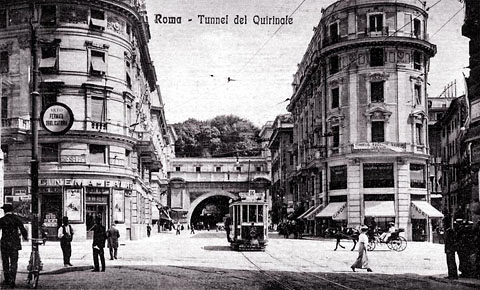 Rome Muzzling Auto MakersThe EU is getting tough on car advertisements. Clear information about fuel consumption and emissions will probably soon be required in all ads, in the manner of tobacco and alcohol advertising. Let's hope that health notices will also be required.More significantly, the falseness of car ads may be reined in. Both words and images may be restricted, and incitement to reckless driving curbed. They have brought this on themselves. A recent billboard featuring a luxury car did contain the required information regarding its (poor) fuel economy - in type so small that it can only be read while standing right in front of the sign. It was claimed that these offenses were merely a breach of self-regulation. However, the regulations are in fact already law (see Directive 1999/94/Ec of the European Parliament and of the Council of 13 December 1999). EU ministers might themselves take a leaf from this. Only the Environment Commissioner, Stavros Dimas, drives a small hybrid. The rest drive big cars. See also the Advertise CO2 campaign of Friends of the Earth. Europeans can file a complaint at this site.
"EU may force car makers to reveal emissions in adverts" 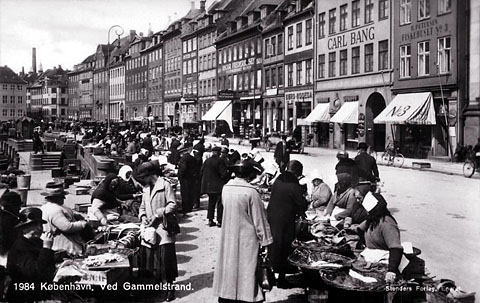 Copenhagen More Bikes, More Money in the TillIn many cities with a weakly-developed bike culture, community resistance often arises to plans for improving bike infrastructure. In particular, it is the merchants who are most likely to oppose this. They think that all customers come by car.In the 1960s, Copenhagen started to pedestrianize the city center but ran into vocal opposition from shop owners. The city went ahead anyway. And so the Strøget was born, one of the fruits of urban planner Jan Gehl. Commerce not only did not suffer, it improved. The greatly increased pedestrian and bike traffic brought more people into the stores. It turns out that cyclists are better customers in many categories. A study in Münster yielded some useful statistics. Cyclists purchase smaller quantities each time they shop, but they shop more frequently, 11 times a month as opposed to 7 times for motorists. Motorists make up on 25% to 40% of customers in urban shops. Barely 25% of motorists leave a shop with more than one bag of goods, compared to 17% of cyclists. Therefore, 75% of motorists could use other transport modes. A study in Berlin showed a massive increase in cross-neighbourhood movement when a 30 km/hr speed limit was introduced for cars not traveling on major routes. People simply used their bikes and public transport to get around. The result was that they found themselves up to 40% more mobile. A survey in Strasbourg indicated a greater than 30% increase of visits to the center-city shopping area following pedestrianization and closure of the city center to through car traffic.
"Cyclists Are Better Shoppers Than Motorists" |
|
Books & FilmsQuite a pile of books came in for review this summer. I only had time to read one of them. I wrote a full review of Leisureville, which comes after the other four, briefly-noted books. At some point I may find the time to read and review them, but they are timely, so I mention them now. I regret being able to do no more than pass along the publishers' blurbs for these.
This looks like an interesting book, and it is mercifully short. From the back cover: A Green Majority
This book has been clamoring for attention for some time now, but I have not been able to do more than thumb through it. It looks interesting. The author is well known in the field and has published extensively. Production values are rather low, and the illustrations are not always easy to read. The publisher says: A step-by-step guide to more synthetic, holistic, and integrated urban design strategies, Design Charrettes for Sustainable Communities is a practical manual to accomplish complex community design decisions and create more green, clean, and equitable communities.
This book is better produced than the other Island Press book mentioned just above. Once again, drawing from the publisher's blurb: Cities are growing at unprecedented rates. Most continue to sprawl into the countryside. Some are only now adopting policies that attempt to control air pollution from vehicles, reduce water pollution from urban runoff, and repair fragmented urban ecosystems. Can good urban design and sound environmental design coincide at a neighborhood level to create healthy communities?
This book is from the man who ran the Energy Information Administration at the US Department of Energy for eight years. It may give an interesting perspective, given the author's resumé. Excerpted from the book's promotional web site: In response to the oil crises of the 1970s, America developed a bipartisan energy policy that made us safer, greener, and far less dependent on foreign oil. It was so successful that American oil imports fell by 50% and greenhouse gas emissions dropped 9% in just five years. How was this possible, and how can we do it again?
In Carfree Cities I mentioned briefly that golf-cart-oriented retirement communities had enjoyed some success in the USA. I had not realized just how much success. In Leisureville, Blechman reports from the front lines, in particular from The Villages in Florida. This book could have been a paean to worry-free retirement living, or a muck-raking exposé of a hedonistic pleasure garden fuelled by booze and Viagra. Instead, it is a balanced examination of the phenomenon of age-segregated retirement communities in the USA. These communities, and their developers, have enjoyed phenomenal success in the past decade. The Villages sprawls across three counties in northern Florida, with an ultimate population of 110,000. It is already large enough to be the tail wagging the rest of the county and has taken over politics in Sumter County. The Morse family, its developer, has made a huge fortune. The business plan is simple: get relatively young "elders" to retire behind the gates of communities where no one under age 55 is allowed to buy a house (and where visitors, especially including children, are not allowed to spend more than 30 days in any one year). These are intended to be elder utopias, free from the annoyances of the real world, including sometimes-unruly children. They are also usually free of the expense of educating those children. I had intended only to skim through the book but found myself reading it. It's not too long, reads well, and holds your interest. I can believe the author's reports of thousands of happy seniors living a great life in their early old age. Costs are low, services are good, the weather is never cold (although I have to wonder if the author has ever been through a Florida summer). Old folks meet each other and have a grand old time together. At least that's the marketing hype. And for a lot of people, the reality seems to be what they want. For others, the situation is different: [Son Carl said] "... this place is fucked up!" His brother, Ben nods in agreement. I ask them if their mother is happy here. "She misses some things," Carl says.People leave the snow belt to move into these places, leaving behind their friends and family in the north. (One reason this works is that people have become so rootless in the USA that they may not be near family to begin with and may not have made many friends in the place they happened to be living.) Lubricated by alcohol, quick if superficial friendships develop in these places. Blechman mentions the search for community and its special importance for older people, a circumstance that warrants further consideration. But why don't they have community where they are living now? These people are in large measure driven by fear. What do they fear? "Children." Well, not really children, I think. Teenagers, probably. "Children don't fit the lifestyle we've got in The Villages," Pat says. "You can't mix the two. It's either one or the other, but not both. If this place was multigenerational, there'd be a lot more crime. We'd have drug busts, wild parties, loud stereos, auto accidents. It wouldn't be the same. We'd be shoved to the side. And afraid." (p.171)I recall that when I was a school kid, even the teenagers were reasonably respectful of teachers and other adults with whom they came in contact. That seems to have changed in the USA. Teens are increasingly alienated from their elders. There is an increasing percentage of fatherless boys (caused by rampant divorce and families subsequently split by distance). Research increasingly shows that teenage boys without fathers, or at least father-figures, are very likely to wind up in trouble with the law. So life in the real world of the USA is pretty scary for folks who are past their prime. And maybe the kids are mad at us about the mess we're planning to leave them. How are these places run? Quite simply, they are run by the developer for the developer. There is only one check on unbridled greed - if people don't like it, they won't buy it. The details of governance are pretty raw. In The Villages, the Morses have a stranglehold on everything. They own all the media and, directly or indirectly, have nearly full control of everything that happens inside "their" development. The formula has been carefully refined to keep the retirees happy, and most of them seem not to resent their near-total lack of control over the management of the communities they live in. And what of the golf carts? Yes, there are thousands of them, they are used very extensively, driven fairly slowly (typically about 25 MPH), and mostly isolated from other traffic. These carts undoubtedly run on batteries and are pretty quiet. Speeds are slow enough to reduce danger. People like not having to drive, and the open position really does seem to facilitate casual social contact. These places sprawl across miles, and biking is probably not a realistic option for most residents, especially during the nine months of the year when it gets hot. The marketing hype is so broad and deep that it even extends to the fabrication of history: As the canopied boat put-puts away from the dock, Dickie points to the lighthouse up ahead, and claims that it was built by a "Yank" named Will B. Wagner more than 150 years ago. "He was a character among characters, but the locals liked him and called him the Commodore," Dickie tells us. "It took him ten years to complete the lighthouse, starting in 1835. The Historical Society came in and restored it some years ago." The other passengers nod their heads hesitantly, unsure whether or not to believe this tale. (p.63)The lighthouse in question, utterly superfluous on the small pond, is just a few years old. This blurring of reality and fantasy might almost be seen as the leitmotif of these places - we'll pretend that growing old is just as much fun as being carefree children. Mix in enough booze (and a remarkable amount of marijuana), and these fantasies can become sufficiently real to satisfy many of the residents. Perhaps as deeply disturbing to me as anything is that I have been eligible for one of these "geritopias" for five years. This generation, my generation, that is moving into these places and shedding its obligations to the larger society, is the richest, most pampered generation in all history. It is a generation that has made few sacrifices and appears satisfied to leave a legacy of global warming, fuel shortages, and government-by-corporation, as long as it's fun on the way out. I'm revolted by this. And ashamed. [S]omething's rotten at the core of these leisurevilles. While it's not for me to say seniors shouldn't enjoy themselves, the reality behind age segregation is another matter. No clever euphemism can hide the fact that these communities are based on a selfish and fraudulent premise - the exclusion of children and families. And no amount of volunteerism and continuing education courses - however admirable or enriching - can compensate for the high societal price of this exclusionary lifestyle. (p.220)So what is the alternative? Well, carfree cities, of course. If we had the improved socialization that children get from living in a community where street life is real and important, and if we had places people could get around in without cars, and if we had real community, maybe older people would be happy enough just to stay where they are and continue to contribute to a community of which they had been a part all of their lives. This to me seems a more reasonable and satisfying arrangement than spending the last 30 years of life wondering which golf course to play today and which widow to bed tonight.
Hot New LinksThe links below will open in a new browser window:
Cycling for Everyone: The Key to Public and Political Support [PDF!] The technically-minded may be interested in a series of pages on high-speed rail in California. Consider this tidbit: On a route like Sapporo-Kushiro, a steep mountain route with very tight curvature, heavy snowfall, and a soft roadbed, JR Hokkaido achieves the same average speed, and higher reliability, as the fastest Amtrak trains on straight track in the deserts of the western USA. Hans-Joachim Zierke
You have always known that Amtrak does not know how to run a railroad. Now you can find out why, from a gentleman who is the embodiment of the practical engineer:
The Shasta Route
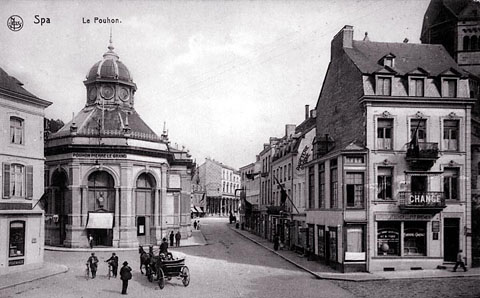 Spa About Carfree Times
Next Issue
Subscribe to Carfree Times
Write for Carfree Times
|
| Editor | J.H. Crawford |
| Send e-mail | |
| URL | http://www.carfree.com/
|
Back to Carfree.com
Carfree Times Home
Back to Carfree Times Issue 50
Forward to Carfree Times Issue 52
-->
About the book: Carfree Cities
E-mail
carfree.com
Copyright ©2008 J.Crawford


